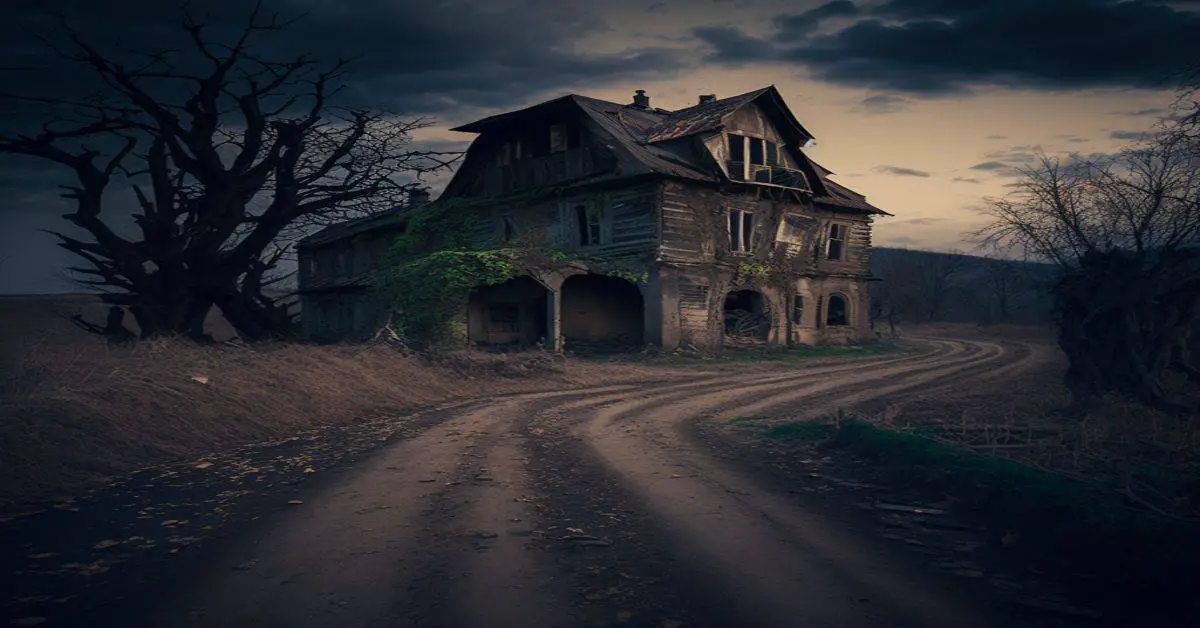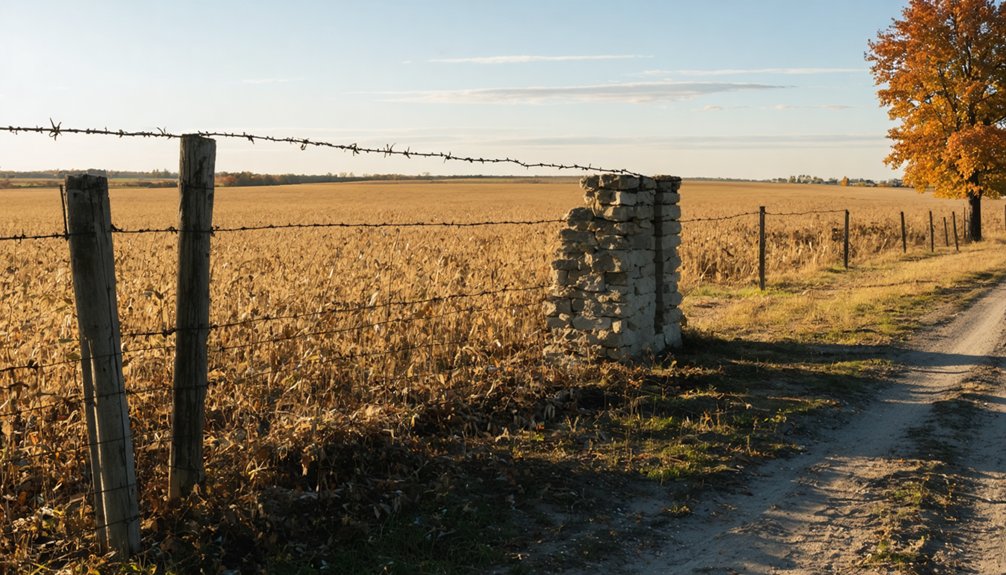You’ll find Gurney, Illinois’ haunting remains in Ashland Township, Cass County at 39°53′57″N 90°03′00″W along Route 125. This former farming settlement, established in the 1830s, featured a community house and schoolhouse that served fifteen students. Time hasn’t been kind – economic shifts and population decline transformed it into a ghost town. Today, scattered architectural remnants like the “pizza slice” building and stone sharpening wheel tell stories of its agricultural past. The site’s rich history holds countless untold tales.
Key Takeaways
- Gurney is a former settlement in Ashland Township, Cass County, Illinois, located at 39°53′57″N 90°03′00″W along Illinois Route 125.
- The town originated around 1835 with a community house and later included the Gurney School, built in 1883.
- Economic shifts, declining transportation routes, and regional out-migration led to Gurney’s transformation into a ghost town.
- Physical remnants include unique structures like the “pizza slice” building, wood plank roads, and a large stone sharpening wheel.
- The site has largely returned to agricultural land, though its layout can still be traced through remaining gravel roads.
Location and Geographic Significance
The small ghost town of Gurney lies within Ashland Township of Cass County, Illinois, positioned at 39°53′57″N latitude and 90°03′00″W longitude along Illinois Route 125.
You’ll find it nestled between the towns of Philadelphia and Ashland in the heart of central Illinois’ rich agricultural landscape. The settlement’s strategic location along key transportation routes made it significant for local trade and commerce during its heyday.
The town had a rudimentary medical facility where patients were transported on simple folding stretchers during emergencies.
Situated in the region’s characteristic flat to gently rolling terrain, Gurney emerged as part of the 19th-century pattern of rural development. Similar to the Des Plaines River area where Gurnee later developed, the land supported early settlement and growth.
While no major rail lines served the town directly, its position along Route 125 provided essential connections to neighboring communities. The surrounding fertile soil supported the area’s farming economy, though today you’ll only find scattered rural development where this once-active community stood.
Historical Development
During the early days of Illinois’ rural expansion, Gurney emerged as a modest settlement when pioneers established a community house in 1835-36 to shelter incoming families.
You’ll find this development mirrored many similar towns across Cass County, as settlers carved out new lives in Ashland Township.
Community dynamics centered around the Gurney School, which served as both an educational facility and social hub for local families.
The Gurney School stood as the heart of local life, where education and community bonds flourished under one roof.
Like neighboring settlements, the town’s growth relied heavily on transportation shifts along Illinois Route 125, connecting it to Philadelphia and Ashland.
Without major industrial development or railroad connections, Gurney maintained its rural character, supported by small-scale agricultural services and basic amenities that were typical of 19th-century Illinois hamlets.
Similar to Buda’s peak population of nearly 1500 residents in the late 1800s, Gurney experienced modest growth during this period of rural development.
The town’s economy differed from other Illinois settlements like Old Shawnee Town, which prospered from its rich salt deposits and strategic location.
Rise and Fall of a Rural Settlement
Like many rural settlements in Illinois, Gurney faced mounting pressures that would ultimately lead to its decline.
You’ll find its story mirrors the economic shifts that transformed countless small towns across the state, where the decline of railroads and mining stripped away their foundational industries.
As mines dried up and railroad importance diminished, you’d have witnessed the community’s resilience tested by waves of out-migration.
The town, situated in Cass County, gradually evolved from a vibrant settlement to a ghost town.
Similar to the dramatic drop in Alexander County’s population from 20,000 to 5,000 residents, Gurney experienced a severe demographic decline.
The familiar pattern of infrastructure decay set in – abandoned buildings, deteriorating roads, and the shuttered Gurney School stand as silent witnesses to this change.
Agricultural changes and broader industrial downturns removed the economic incentives that once made Gurney a viable community.
What remains of Gurney today has largely been converted into productive farmland, following the common fate of abandoned Illinois towns.
Life in Early Gurney
Early settlers in Gurney built their lives around a close-knit farming community, where you’d find families working together to cultivate the fertile Illinois soil.
You’d see neighbors helping each other during harvest seasons, sharing equipment and labor to maximize their yields in the challenging continental climate.
Community gatherings centered around the local schoolhouse, where children learned their lessons in a single room while farming practices were passed down from one generation to the next.
The one-room schoolhouse served as both educational hub and cultural anchor, nurturing young minds while preserving agricultural heritage.
Following the Treaty of Prairie Du Chien, settlers arrived in 1835 seeking affordable land to establish new homesteads.
You’d experience the rhythm of rural life through seasonal celebrations, church activities, and shared meals.
Despite limited access to healthcare and modern conveniences, residents relied on strong family bonds and neighborly support.
The natural surroundings provided resources for sustenance, while trade with nearby Philadelphia and Ashland supplied additional necessities.
Like many communities in The Sucker State, Gurney’s residents primarily focused on agricultural development.
Physical Remnants and Legacy
Today, scattered remnants of Gurney’s past dot the rural Illinois landscape, offering glimpses into its agricultural heritage.
You’ll find the distinctive “pizza slice” building, a unique piece of physical architecture that mirrors similar triangular structures across the Midwest. Behind weathered windows, you can spot the ruins of wood plank roads and scale setups where farmers once weighed their grain harvests. Like the historic lime kiln at Griggsville Landing, these structures tell the story of Illinois’ industrial past.
The cultural significance of Gurney lives on through artifacts like the large stone sharpening wheel near an old disposal area. Similar to other small Illinois towns experiencing steep population decline, many residents left during the early 1900s seeking opportunities elsewhere.
While most original buildings have succumbed to time, the site’s layout can still be traced through remaining gravel roads and the path of Illinois Route 125.
The land has largely returned to its agricultural roots, with farmland reclaiming what was once a bustling rural community.
Historical Documentation and Research
You’ll find Gurney’s historical record primarily preserved through official township registers and the photographic documentation of its schoolhouse building.
Local historians, particularly Dr. Neil Gale, have contributed valuable research about this Cass County ghost town through careful examination of archival materials and regional records.
While primary source materials remain limited, the town’s inclusion in the Digital Research Library of Illinois History Journal and various ghost town compilations helps maintain its place in Illinois historical records.
Archival Records and Sources
Historical documentation of Gurney, Illinois draws primarily from township maps, government records, newspapers, and railroad archives that paint a picture of this vanished Cass County settlement.
Thanks to archival preservation efforts, you’ll find valuable records scattered across various repositories, with the Illinois GenWeb project making document accessibility easier for researchers and history enthusiasts.
Key archival sources for Gurney include:
- Township maps and gazetteers from Cass County, particularly those showing Gurney’s location along Route 125 between Philadelphia and Ashland.
- Local government documents from Ashland Township, including land transactions and census records.
- Regional newspaper collections containing social notices, obituaries, and railroad-related coverage that mention the settlement.
These materials help piece together Gurney’s story, though some records have been lost to time or remain only partially preserved in county archives.
School Photos and Documents
Limited photographic records survive from Gurney School, which opened its doors in 1883 along Illinois Route 125. You’ll find the school’s documentation scattered across local historical societies and archives, with only basic operational details preserved about this small rural institution that served around fifteen students at a time.
While school artifacts from Gurney remain scarce, you can piece together its educational impact through broader regional sources. The spacious schoolyard with its planned tree coverage appears in surviving photographs, showing how the facility served as a community hub between Philadelphia and Ashland.
State historical societies and Dr. Neil Gale’s research have helped preserve what little is understood about this ghost town school, though most details emerge through secondary sources rather than primary documentation.
Frequently Asked Questions
What Happened to the Students After Gurney School Closed?
As they say, change is constant. You’ll find that student relocation scattered kids to nearby districts after the 1983 closure, though records don’t specify exactly where. The school legacy carried forward until reopening in 1988.
Were There Any Notable Crimes or Mysteries Associated With Gurney?
You won’t find documented Gurney crimes or mysteries in historical records. Unlike other Illinois ghost towns with dark histories, there’s no evidence of criminal activity or unsolved cases from Gurney’s inhabited period.
Did Any Famous People or Events Originate From Gurney?
You won’t find any famous residents or significant historical events linked to this location. Available records don’t indicate any notable personalities or memorable occurrences from this rural community.
What Native American Tribes Previously Inhabited the Gurney Area?
You’ll find the Potawatomi Tribe was dominant in this region, with significant Ojibwe influence nearby. These tribes hunted and gathered across the area before European settlers pushed them westward.
Are There Any Surviving Photographs of Gurney’s Original Buildings?
Despite its architectural significance, you won’t find any surviving photographs of Gurney’s original buildings in historical preservation archives. The town’s visual legacy, ironically, has vanished just like the settlement itself.
References
- https://www.youtube.com/watch?v=gM3ZIgtFzBk
- https://www.heraldtimesonline.com/story/lifestyle/home-garden/2021/01/15/some-illinois-ghost-towns/43846097/
- https://drloihjournal.blogspot.com/2022/09/lost-towns-of-illinois-gurney-illinois.html
- https://drloihjournal.blogspot.com/p/lost-towns-of-illinois-series.html
- https://en.wikipedia.org/wiki/Gurney
- https://sangamoncountyhistory.org/wp/14696/
- https://en.wikipedia.org/wiki/List_of_ghost_towns_in_Illinois
- https://townsquarepublications.com/history-of-gurnee/
- https://en.wikipedia-on-ipfs.org/wiki/Gurney
- https://en.wikipedia.org/wiki/Gurnee



